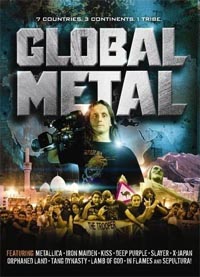(Seville Pictures, 2008, 90 Mins, $10)
Anthropologist Sa m Dunn takes to the air to visit different parts of the world where heavy metal is booming. In doing so, he acknowledges the transition the genre has made from being a developing movement in the west, to a genre which has reached an end to its maturation and now is another voice into which others project. Indeed, as he visits anti-religious metalheads, religious metalheads, anti-Zionist metalheads and Zionist metalheads, teen rebels and people looking for a voice for their ancestral cultures that can compete with the booming sound of the West, Dunn discovers a change in metal. No longer is it being absorbed by a global audience, but changed by a global audience. He does this through a winding narrative featuring many shots of the director, often using his bemused poker face to poke innocently where trouble might lie. Knowing that interviews alone make a boring documentary, he intersperses them with tour de force cinematography that shows us the vastness and beauty of these different places, and music videos mostly featuring concert shots from each location. The intelligent choice here is to avoid “norming” places by emphasizing the we’re-all-the-same message. Dunn lets his camera and his subjects do the talking, although his frequent voice-over covers the boilerplate dogma we’re accustomed to hearing: metal is about self-expression, freedom, free speech, being an individual, and so on. But as time goes on, we see how metal is about being in a group that accepts the individual’s desire for rage and figuring things out themselves. Dunn’s final narrative affirms this: metal is a worldwide subculture to which people belong more than the politics of their nations. It is as if through his eyes, metal is a shout of rage at the modern world which has assimilated culture in its manic desire for power and commerce, and the insurgent forces of Hessians worldwide are reclaiming culture by first distancing themselves from it. For the person who is rightfully as cynical of the nitwit pretensions of individuals as of the face of state power, many of the people interviewed come across as surface treatments, and this is a general criticism of Dunn’s films we have all heard before. In the name of making them accessible, he pushes back the anthropology in favor of reveling in the power of the movement itself. For now, that’s not half bad.
m Dunn takes to the air to visit different parts of the world where heavy metal is booming. In doing so, he acknowledges the transition the genre has made from being a developing movement in the west, to a genre which has reached an end to its maturation and now is another voice into which others project. Indeed, as he visits anti-religious metalheads, religious metalheads, anti-Zionist metalheads and Zionist metalheads, teen rebels and people looking for a voice for their ancestral cultures that can compete with the booming sound of the West, Dunn discovers a change in metal. No longer is it being absorbed by a global audience, but changed by a global audience. He does this through a winding narrative featuring many shots of the director, often using his bemused poker face to poke innocently where trouble might lie. Knowing that interviews alone make a boring documentary, he intersperses them with tour de force cinematography that shows us the vastness and beauty of these different places, and music videos mostly featuring concert shots from each location. The intelligent choice here is to avoid “norming” places by emphasizing the we’re-all-the-same message. Dunn lets his camera and his subjects do the talking, although his frequent voice-over covers the boilerplate dogma we’re accustomed to hearing: metal is about self-expression, freedom, free speech, being an individual, and so on. But as time goes on, we see how metal is about being in a group that accepts the individual’s desire for rage and figuring things out themselves. Dunn’s final narrative affirms this: metal is a worldwide subculture to which people belong more than the politics of their nations. It is as if through his eyes, metal is a shout of rage at the modern world which has assimilated culture in its manic desire for power and commerce, and the insurgent forces of Hessians worldwide are reclaiming culture by first distancing themselves from it. For the person who is rightfully as cynical of the nitwit pretensions of individuals as of the face of state power, many of the people interviewed come across as surface treatments, and this is a general criticism of Dunn’s films we have all heard before. In the name of making them accessible, he pushes back the anthropology in favor of reveling in the power of the movement itself. For now, that’s not half bad.

